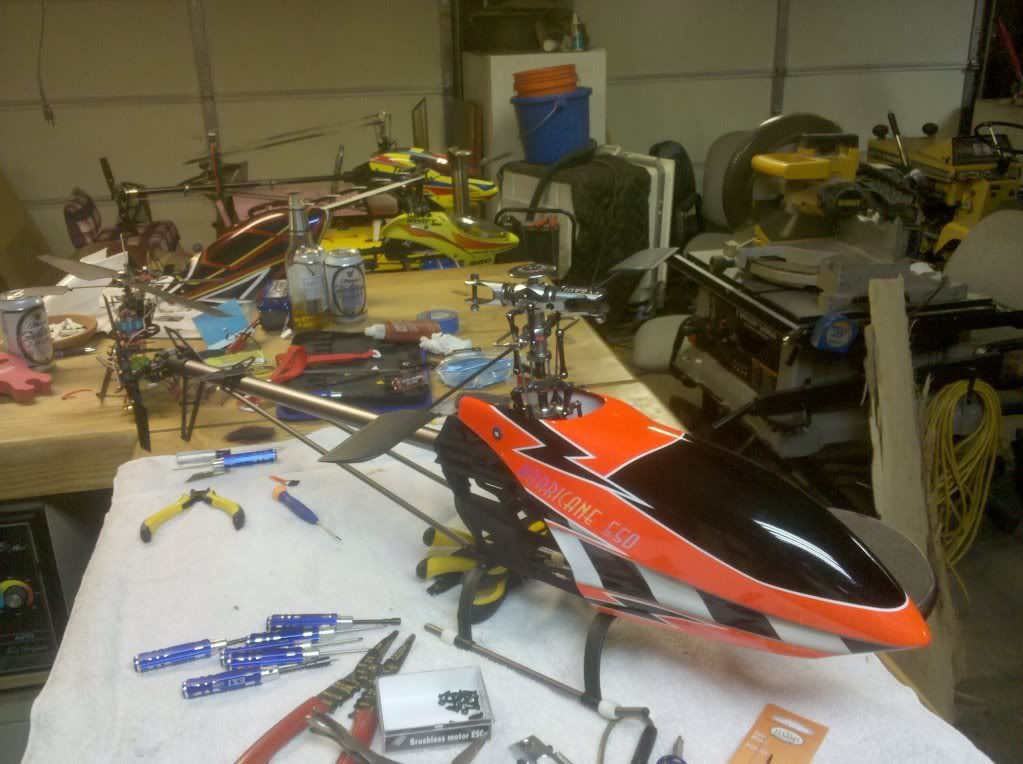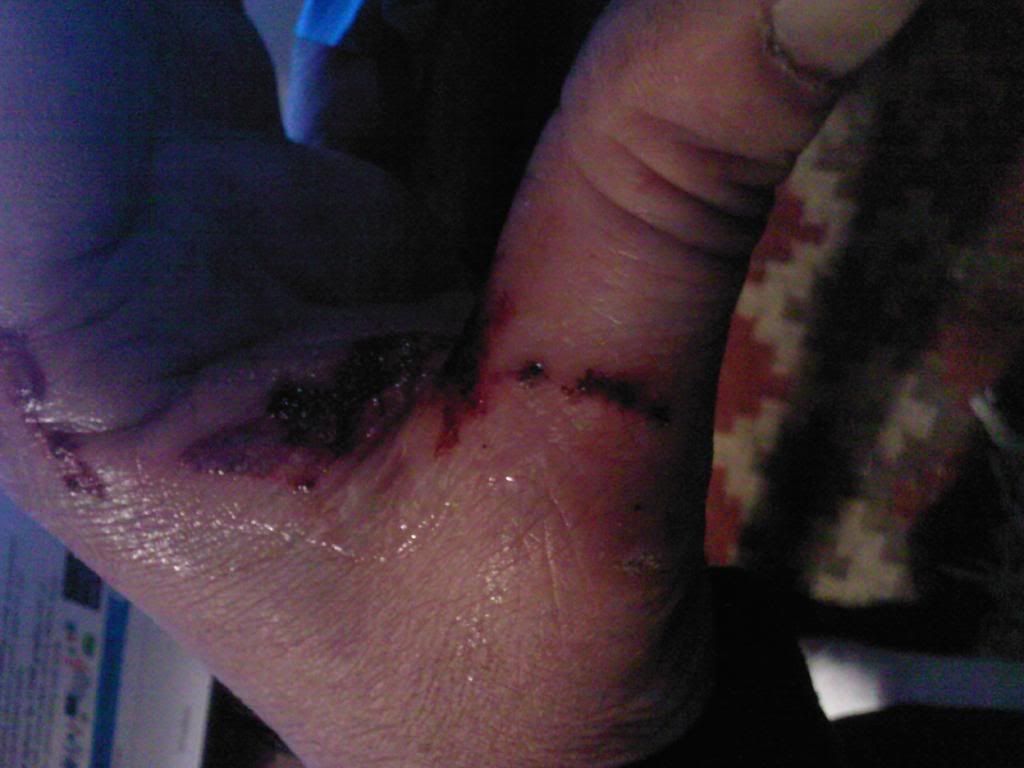Post by dunkonu23 on Feb 4, 2010 0:27:56 GMT -5
I wrote this in response to a user on another forum, but I thought some of us may get some use out of it here.
Cyclic Pitch adjustment and Equal pitch correction.
1. Lock the flybar. It's easier this way unless you have a helper to hold it perpendicular to the main shaft! Zero all transmitter trims (not subtrims).
2. Pitch: Mid throttle stick. Rotate blades until they're perpendicular to the frame. While using a pitch gauge, raise and lower the elevator (forward and back on the cyclic stick) and measure pitch at the extremes. You adjust this to your liking via the Swash mix menu, elevator or pitch setting.
3. Aileron: Mid throttle stick. Rotate blades until they're parallel to the frame. While using a pitch gauge, move the cyclic stick side to side (try to move it in only that axis) and measure pitch at the extremes. You adjust this to your liking via the Swash mix menu, aileron setting.
Tame settings would be something like:
Raw Beginner:
Collective pitch +-9
Cyclic (aileron and pitch/elevator) +-3
More advanced than beginner:
Collective pitch: +- 11
Cyclic (aileron and pitch/elevator) +-5 through 7
Advanced:
Collective pitch +-12 through 15
Cyclic (aileron and pitch/elevator) +-8 through 14
(I read were Bert Kammerer uses +-15 collective +- 14 cyclic... wow!)
Those are very tame settings, and the helicopter should be very easy to fly with them. Altermatively, you can use pitch curves to further tame collective pitch by adjusting your pitch curve low value to something like 40 or 45. That will give you almost no negative pitch and the helicopter will perform almost like a fixed pitch helicopter if you fly in normal mode.
What happens if your pitch settings are not equal at extremes with a pitch curve like 0-50-100? The first thing to check are the servo arms. On the Gaui, the control arm positions are well documented in the manual, but they need to be flat at 50 percent throttle stick. If they're not, they need to be..Adjust servo wheel/arm/crank position and/or link lengths on the servo so that you get the arms to be level. That's step one.
The next thing I'd check are the washout arms. At 50 percent throttle with the pitch curve at 0-50-100, they should be level. If they're not level, the links from the control arms to the swashplate need to be sized. Once you get the washout arms level, make sure the swashplate is level at 50 percent throttle. Do that either with a swash plate leveler, or eyeball it. I can get pretty close by eyeballing. Altermatively, once you have the washout arms level in one position, while rotating the shaft, keep an eye on the washout arm ends. They should stay in the same position -- level with each other -- all the way around. If they aren't you can adjust the appropriate links to make sure the arms don't change their position. But I still use a swash plate leveler, it's easier.
Next, raise the throttle stick to max. Check the swash plate for level. If it's not level, use Servo travel limits to make the swashplate level. After that, lower the stick completely and level the swash in that position using servo travel limits.
Now, then... what happens if you have pitch that is unequal and everything checks out? Chances are when you leveled your swash at extremes, you adjusted your servo end points in the wrong direction. When you're at the top extreme, you should adjust up. For example, if you have two points that are lower, raise them to match the high point. At the lower extreme, adjust down.
Scott
Cyclic Pitch adjustment and Equal pitch correction.
1. Lock the flybar. It's easier this way unless you have a helper to hold it perpendicular to the main shaft! Zero all transmitter trims (not subtrims).
2. Pitch: Mid throttle stick. Rotate blades until they're perpendicular to the frame. While using a pitch gauge, raise and lower the elevator (forward and back on the cyclic stick) and measure pitch at the extremes. You adjust this to your liking via the Swash mix menu, elevator or pitch setting.
3. Aileron: Mid throttle stick. Rotate blades until they're parallel to the frame. While using a pitch gauge, move the cyclic stick side to side (try to move it in only that axis) and measure pitch at the extremes. You adjust this to your liking via the Swash mix menu, aileron setting.
Tame settings would be something like:
Raw Beginner:
Collective pitch +-9
Cyclic (aileron and pitch/elevator) +-3
More advanced than beginner:
Collective pitch: +- 11
Cyclic (aileron and pitch/elevator) +-5 through 7
Advanced:
Collective pitch +-12 through 15
Cyclic (aileron and pitch/elevator) +-8 through 14
(I read were Bert Kammerer uses +-15 collective +- 14 cyclic... wow!)
Those are very tame settings, and the helicopter should be very easy to fly with them. Altermatively, you can use pitch curves to further tame collective pitch by adjusting your pitch curve low value to something like 40 or 45. That will give you almost no negative pitch and the helicopter will perform almost like a fixed pitch helicopter if you fly in normal mode.
What happens if your pitch settings are not equal at extremes with a pitch curve like 0-50-100? The first thing to check are the servo arms. On the Gaui, the control arm positions are well documented in the manual, but they need to be flat at 50 percent throttle stick. If they're not, they need to be..Adjust servo wheel/arm/crank position and/or link lengths on the servo so that you get the arms to be level. That's step one.
The next thing I'd check are the washout arms. At 50 percent throttle with the pitch curve at 0-50-100, they should be level. If they're not level, the links from the control arms to the swashplate need to be sized. Once you get the washout arms level, make sure the swashplate is level at 50 percent throttle. Do that either with a swash plate leveler, or eyeball it. I can get pretty close by eyeballing. Altermatively, once you have the washout arms level in one position, while rotating the shaft, keep an eye on the washout arm ends. They should stay in the same position -- level with each other -- all the way around. If they aren't you can adjust the appropriate links to make sure the arms don't change their position. But I still use a swash plate leveler, it's easier.
Next, raise the throttle stick to max. Check the swash plate for level. If it's not level, use Servo travel limits to make the swashplate level. After that, lower the stick completely and level the swash in that position using servo travel limits.
Now, then... what happens if you have pitch that is unequal and everything checks out? Chances are when you leveled your swash at extremes, you adjusted your servo end points in the wrong direction. When you're at the top extreme, you should adjust up. For example, if you have two points that are lower, raise them to match the high point. At the lower extreme, adjust down.
Scott








